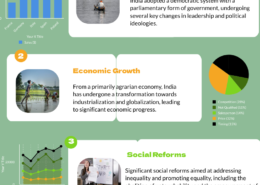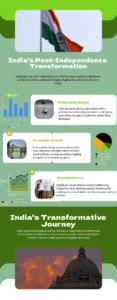Explain direct tax and indirect tax with examples. Differentiate it. How it is impose?
Introduction India's workforce is predominantly informal, with over 90% of workers engaged in informal employment. This extensive informality poses challenges to achieving inclusive growth, as it often results in job insecurity, limited access to social security, and reduced productivity. Body ImpacRead more
Introduction
India’s workforce is predominantly informal, with over 90% of workers engaged in informal employment. This extensive informality poses challenges to achieving inclusive growth, as it often results in job insecurity, limited access to social security, and reduced productivity.
Body
Impact of Informal Workforce on Inclusive Growth
- Limited Social Security and Welfare Benefits: Informal workers often lack access to essential welfare measures, including provident funds, pensions, health insurance, and maternity benefits, which increases their vulnerability.
- According to the International Labour Organization (ILO), only 24% of India’s workforce has social security coverage, which exacerbates economic inequality and social exclusion.
- Income Instability and Poverty: Informal workers on average have incomes 19% lower than formal workers (World Bank) and face unpredictable incomes and lack job security, making it challenging to escape poverty and contribute to sustained economic growth.
- Gender Inequality in Employment: A significant proportion of female workers are engaged in informal employment, often in low-paid, unregulated jobs without maternity benefits or workplace protections.
- 81.8% of women’s employment in India is concentrated in the informal economy (ILO)
- Reduced Tax Revenue and Resource Allocation: The informal sector operates largely outside the tax net, leading to lower government revenue, which constrains public spending on healthcare, education, and infrastructure.
- An estimated 50% of India’s GDP is generated by the informal sector, creating a substantial gap in potential tax collections and fiscal resources for development.
- Limited Access to Credit and Financial Inclusion: Informal workers and enterprises often lack formal financial records, making it challenging to access credit from formal banking channels, which limits their business growth and asset creation.
Potential Solutions for Formalising the Economy and Protecting Vulnerable Workers
- Extending Social Security and Welfare Programs: Pradhan Mantri Shram Yogi Maan-Dhan (PMSYM) and Ayushman Bharat should be expanded to cover informal sector workers comprehensively, offering them access to pensions, health insurance, and income support.
- This would require collaboration between the central and state governments to create a unified social security portal accessible to all workers.
- Incentivizing Formal Employment Through Tax and Policy Support: The government can offer tax breaks and subsidies to companies that transition informal workers to formal employment, particularly in labour-intensive sectors like textiles and construction.
- Implementing Skill Development and Training Programs: The Pradhan Mantri Kaushal Vikas Yojana (PMKVY) should prioritise training for informal workers, equipping them with skills that facilitate formal employment.
- Simplifying Compliance and Reducing Regulatory Burden: Simplifying labour codes and reducing compliance costs for small businesses could encourage informal enterprises to register and operate formally.
- The Code on Wages and Occupational Safety, Health, and Working Conditions Code should be streamlined and implemented effectively.
- Promoting Digital Financial Inclusion and Formal Credit Access: Expanding digital platforms like Jan Dhan-Aadhaar-Mobile (JAM) trinity can enable informal workers to access formal banking and credit facilities, increasing their financial stability and encouraging savings.
Conclusion
Formalising India’s informal workforce is crucial for achieving inclusive growth. By implementing supportive policies, enhancing financial inclusion, and providing social security, India can transition towards a more equitable and productive economy, ensuring that the benefits of growth are shared by all segments of society.
See less


Direct tax is a tax which is submitted by any individual or organization directly to the government as it is imposed to them based on their net worth . On the other hand Indirect tax refers to those tax are liable to pay an can be shifted to others , these are administered and governed by the CentraRead more
Direct tax is a tax which is submitted by any individual or organization directly to the government as it is imposed to them based on their net worth . On the other hand Indirect tax refers to those tax are liable to pay an can be shifted to others , these are administered and governed by the Central Board of Indirect Taxes and Customs . Example are sales tax , customs duty etc . Direct tax governed by Central Board of Direct Taxes .
See less